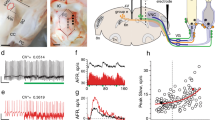Abstract
RECENTLY when recording afferent impulse activity in the nerve supplying the carotid labyrinth in the toad, we have found chemoreceptor fibres which show increased discharge in response to hypoxia just as do those of the mammalian carotid body1. Although acetylcholine has been proposed as the normal chemical transmitter of the mammalian glomus nerve-endings2–8 the evidence is not as yet wholly conclusive. Indeed, electron microscopy has revealed that the mammalian glomus epithelioid cells show numerous catecholamine-containing granules and the opinion has been advanced that the catecholamine may be the transmitter substance3. There is little physiological evidence for this, however, and even noradrenaline itself does not stimulate chemoreceptor discharge6. Based on the standpoint that the adrenaline-like substance produced in the body is not necessarily solely identifiable with noradrenaline, we have tried to stimulate carotid chemoreceptor discharge by electrical excitation of the cardiac sympathetic fibres. Our results indicate that an adrenergic mechanism is responsible for chemosensory transmission.
This is a preview of subscription content, access via your institution
Access options
Subscribe to this journal
Receive 51 print issues and online access
$199.00 per year
only $3.90 per issue
Buy this article
- Purchase on Springer Link
- Instant access to full article PDF
Prices may be subject to local taxes which are calculated during checkout
Similar content being viewed by others
References
Ishii, K., Honda, K., and Ishii, K., Tohoku J. Exp. Med., 88, 103 (1966).
Heymans, C., and Neil, E., Reflexogenic Areas of the Carotid Vascular System (Churchill, London, 1958).
Joels, N., and Neil, E., Brit. Med. Bull., 19, 21 (1963).
Comroe, jun., J. H., Handbook of Physiology, Section 3: Respiration, 1 (Amer. Physiol. Soc., Washington, D.C., 1964).
Eyzaguirre, C., and Koyano, H., J. Physiol., 178, 385 (1965).
Eyzaguirre, C., and Koyano, H., J. Physiol., 178, 410 (1965).
Eyzaguirre, C., and Koyano, H., J. Physiol., 178, 438 (1965).
Eyzaguirre, C., Koyano, H., and Taylor, J. R., J. Physiol., 178, 463 (1965).
Author information
Authors and Affiliations
Rights and permissions
About this article
Cite this article
ISHII, K., ISHII, K. & HONDA, K. Evidence for Adrenergic Transmission of the Carotid Chemoreceptor Impulses in the Toad. Nature 210, 1057–1058 (1966). https://doi.org/10.1038/2101057a0
Issue Date:
DOI: https://doi.org/10.1038/2101057a0
This article is cited by
-
Adenosine triphosphatase activity in the carotid body of the cat
Zeitschrift f�r Zellforschung und Mikroskopische Anatomie (1972)
-
Electron Microscopy of the Chemoreceptor Cells of the Carotid Labyrinth of the Toad
Nature (1966)
Comments
By submitting a comment you agree to abide by our Terms and Community Guidelines. If you find something abusive or that does not comply with our terms or guidelines please flag it as inappropriate.



